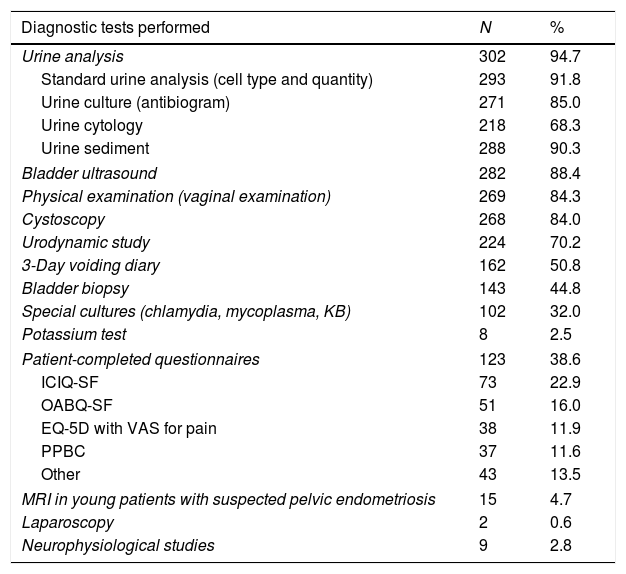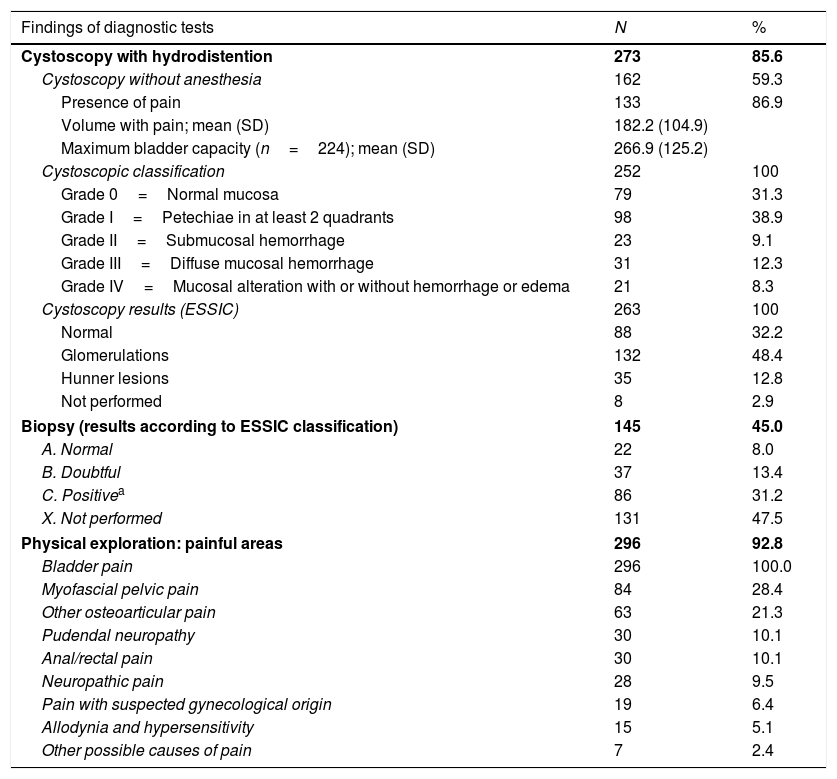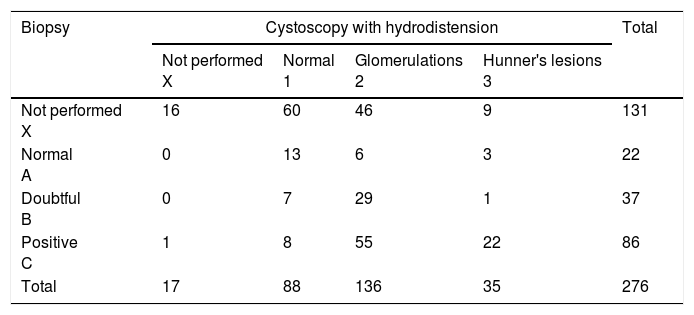Bladder pain syndrome (BPS) is classified as a rare chronic debilitating disease and its diagnosis presents a challenge because its symptoms overlap with those associated with overactive bladder syndrome. The aim of the routine study was to estimate the prevalence of BPS and discover to study the profile of symptoms and clinical practice for patients attending functional urology and urodynamics units.
Material and methodsAn epidemiological study in which 37 functional urology and urodynamics units in Spain participated. The prevalence was studied in both sexes. Clinical practice was evaluated for 319 women with BPS (new diagnosis or under review). Clinical and sociodemographic data were collected retrospectively. The results were studied of urine tests, cystoscopy, biopsy, physical examination, bladder diary, and those of the four available questionnaires: Patient Perception of Bladder Condition; Bladder Pain/Interstitial Cystitis Symptom Score; EuroQoL-5 Dimensions-5L and Patient Global Impression of Severity.
ResultsFive point four percent (503) of the patients who attended these units (9312) had a diagnosis of BPS (90% [453] females). The tests that were performed most according to the clinical history and anamnesis were: urine test, bladder ultrasound and cystoscopy. The most common symptoms/comorbidities were: pain in the bladder region, increased urinary frequency, nocturia, anxiety and depression. Diagnostic assessment determined pain on hydrodistension (86.9%), positive biopsy (59.2%), myofascial pelvic pain (28.4%), urological phenotype (97.8%), and increased urinary frequency (88.7%). The questionnaires reflected how much the quality of life of these patients was affected.
ConclusionsThe prevalence of BPS in functional urology and urodynamics units in Spain is low. No homogeneity was observed in terms of diagnosis between the different participating centers. Therefore, a common methodology is required for the management of patients with BPS in these units, with tools specific to this disorder.
El síndrome de dolor vesical (SDV) está catologado como enfermedad rara y su diagnóstico representa un desafío debido al solapamiento de sus síntomas con los asociados al síndrome de vejiga hiperactiva. El objetivo fue estimar la prevalencia del SDV y conocer el perfil de síntomas y la práctica clínica en pacientes que acuden a unidades de Urología Funcional y Urodinámica.
Material y métodosEstudio epidemiológico en el cual participaron 37 unidades de Urología Funcional y Urodinámica de España. La prevalencia se estudió considerando ambos sexos. Se evaluó la práctica clínica en 319 mujeres con SDV (nuevo diagnóstico o en revisión). Se recogieron retrospectivamente datos clínicos y sociodemográficos. Se analizaron los resultados de análisis de orina, cistoscopia, biopsia, exploración física, diario miccional, así como de los 4 cuestionarios disponibles: Patient Perception of Bladder Condition; Bladder Pain/Interstitial Cystitis Symptom Score; EuroQoL-5 Dimensions-5L y Patient Global Impression of Severity.
ResultadosEl 5,4% (503) de los pacientes que acudieron a estas unidades (9.312) tenían diagnóstico de SDV (90% [453] mujeres). Las pruebas más realizadas según historia clínica y anamnesis fueron: análisis de orina, ecografía vesical y cistoscopia. Los síntomas/comorbilidades más frecuentes fueron: dolor en la región vesical, frecuencia miccional aumentada, nicturia, ansiedad y depresión. La evaluación diagnóstica determinó dolor en hidrodistensión (86,9%), biopsia positiva (59,2%), dolor miofascial pélvico (28,4%), fenotipo urológico (97,8%) y frecuencia miccional aumentada (88,7%). Los cuestionarios reflejaron el elevado grado de afectación de la calidad de vida de estos pacientes.
ConclusionesLa prevalencia del SDV en las unidades de Urología Funcional y Urodinámica en España es baja. No se observa homogeneidad en cuanto al diagnóstico entre los diferentes centros participantes. Por ello, sería necesario establecer una metodología común de manejo de pacientes con SDV en estas unidades, con herramientas específicas para esta patología.
Artículo
Comprando el artículo el PDF del mismo podrá ser descargado
Precio 19,34 €
Comprar ahora













